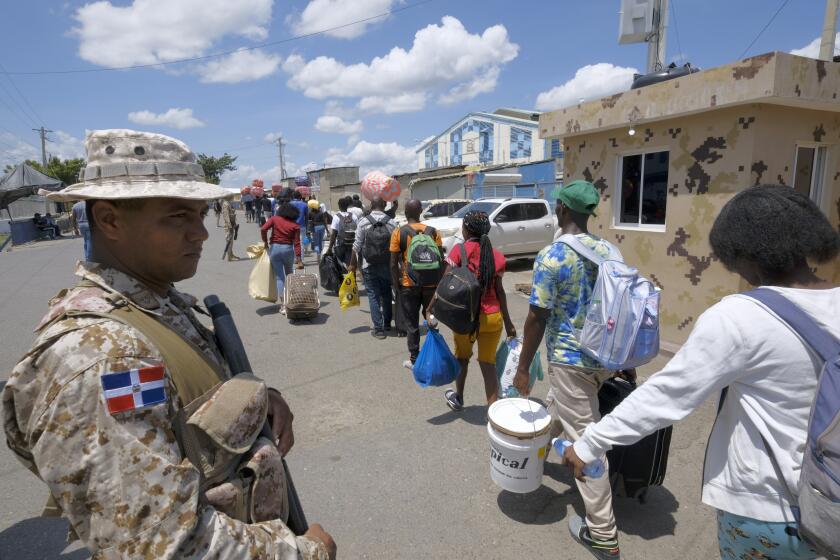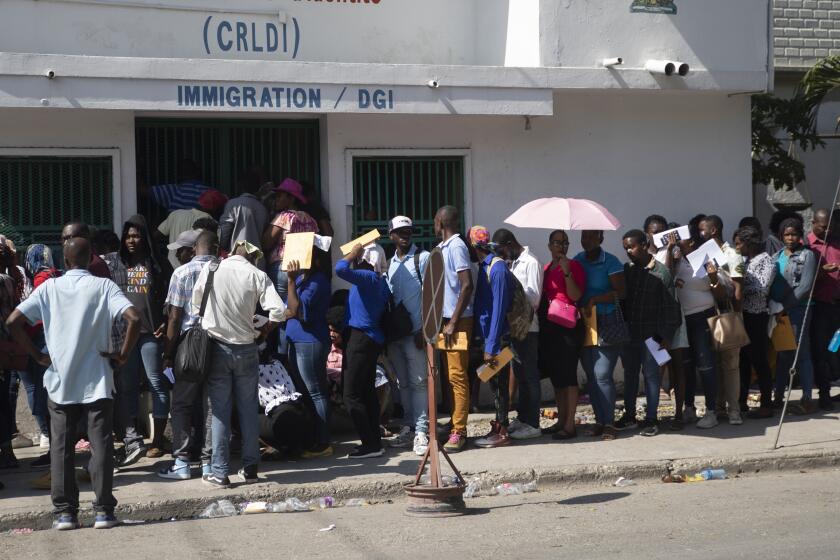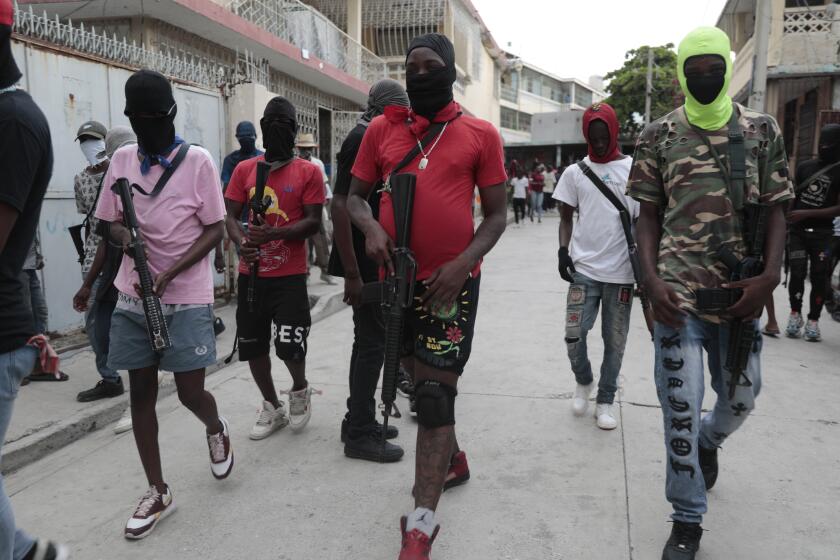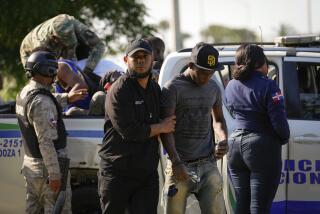Dominican Republic partially reopens border with Haiti while diplomatic crisis persists
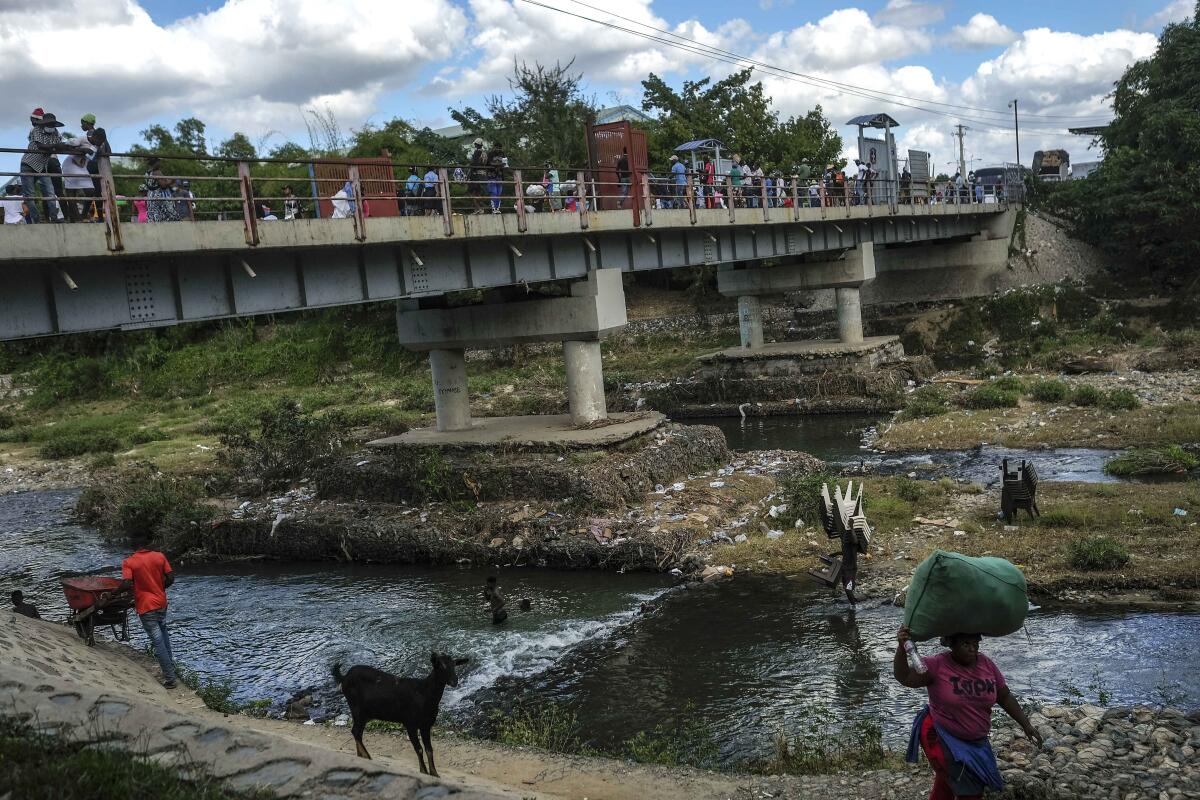
- Share via
DAJABON, Dominican Republic — The Dominican Republic partially reopened its border with Haiti on Wednesday to limited commercial activity nearly a month after shuttering the frontier in a continuing spat over construction of a canal targeting water from a shared river.
Vendors in Dominican border cities are allowed to sell basic goods like food and medicine, but exporting electronic products and construction materials, including cement and metal rods, is prohibited.
Wednesday marked the first time since Sept. 15 that the border partially reopened, although Dominican President Luis Abinader maintained a ban on issuing visas to Haitian citizens that he implemented last month and will keep the border closed to all migrants, regardless of whether they’re seeking entry for work, tourism, health or education purposes.
While the gates at the northern Dominican border city of Dajabon opened late Wednesday morning, the gates on the Haitian side remained closed, and it wasn’t immediately clear why. Meanwhile, dozens of trucks and containers were lined up nearby, filled with goods.
The Dominican Republic has shut all land, air and sea borders with Haiti over a dispute about construction of a canal on Haitian soil.
The Dominican border reopening was delayed after a predawn fire at the main marketplace in Dajabon destroyed dozens of stalls. Authorities said they were investigating what caused the blaze.
The marketplace remained largely empty and quiet as a handful of vendors reopened their stalls nearly a month after they were forced to close.
“There’s been a heavy loss here,” said Santo Rodríguez, who sells pasta, butter, mayonnaise, ketchup and other items in his stall and condemned the border closure. “How are you expected to survive?”
Rodríguez, who first opened his business in 1995 and earns some $176 a week, said that despite Abinader promising to help Dominican business owners affected by the border closure, he hadn’t received any aid.
The most recent diplomatic crisis stemmed from construction of a canal on the Haitian side that aims to collect water from the Massacre River that runs along the border the countries share on the Caribbean island of Hispaniola. The river is named after a bloody 18th century battle between French and Spanish colonizers.
The Dominican Republic president is defending his decision to close air, sea and land traffic with neighboring Haiti in canal construction dispute.
Haiti’s government has said farmers urgently need the water after an extended drought withered crops in the nearby Maribaroux Plain.
Abinader has said construction of a canal violates a 1929 treaty and would divert water needed by Dominican farmers and affect wetlands in the area.
Shortly after the spat began, Abinader ordered officials to revive use of a nearby canal to collect water before the river enters Haitian territory.
On Monday, Haiti’s government issued a statement saying the attempt to divert water from the Massacre River to “deprive Haitians of it” is “unacceptable and hostile.” The statement stressed the need for dialogue and said the only suitable outcome would be an equal sharing of water resources, the normalization of relations between the two countries and a return to the free movement of people and goods.
“This project unleashed quite an exceptional movement of national unity that perhaps was not what Abinader expected,” said Diego Da Rin with the International Crisis Group. “The canal has become an almost historical point of honor. Haitians want to make it clear that they are a nation that will not allow themselves to be humiliated by their neighbor.”
Haitians in Port-au-Prince rush to get a passport, hoping they will be chosen to live legally in the U.S. under President Biden’s immigration plan.
Da Rin said Haitians in general appear willing to forgo certain goods to support construction of the canal. The diplomatic crisis also appeared to be a boon for Haitian Prime Minister Ariel Henry, who has been “extremely unpopular,” Da Rin said.
“He took advantage of this to raise or improve his image a little at a critical moment,” he said.
Many Haitians have backed the government’s stance, including Marie-Enge Belizaire, 60, a merchant in the Tabarre community of the Haitian capital, who had been buying $20,000 worth of clothes monthly from the Dominican Republic for the past 20 years.
She called Abinader’s decision to close all land, sea and air borders last month “savage,” noting that businesses like hers are good for the Dominican Republic.
“We generate money for them,” she said as she sat in a warehouse surrounded by towering columns of boxes filled with clothes.
People waited anxiously in long lines throughout the Dominican Republic on Wednesday, eager to submit applications for legal residency before a midnight deadline and avoid possible deportation.
Belizaire said she supports construction of the canal to ease Haiti’s agricultural crisis and said she is looking into buying clothes from other countries, including Panama.
Among those buying at the warehouse where Belizaire works was Orgline Pierre, 40. She said that even if the Dominican Republic opens its borders, she hopes the Haitian side will remain closed.
“Abinader thinks that Haitian stomachs depend on the Dominican Republic, which is not true,” she said. “We have food. My son is surviving on local food here and is going to keep surviving.”
Pierre said she hopes that the upcoming deployment of a multinational armed force led by Kenya to help quell gang violence would also guarantee the safety of Haitians working on the canal along the border.
The multinational force’s main mission will be to help combat violent gangs engaged in killings and kidnappings in the troubled country.
Prior to the diplomatic dispute, the Abinader administration was pushing to limit the number of Haitians migrating to the Dominican Republic, expelling tens of thousands of them, as well as people of Haitian descent.
The administration also has started building a 118-mile wall along the border.
Haiti and the Dominican Republic have long had a contentious relationship despite strong economic ties.
Haiti is the Dominican Republic’s No. 3 trading partner, with $1 billion in exports to Haiti last year and $11 million in imports, according to the Dominican Republic’s Export and Investment Center.
Meanwhile, the Dominican Republic’s Central Bank found that $430 million in informal border trade was conducted in 2017 between the countries. Of that amount, more than $330 million represented exports to Haiti.
Adames Alcántara reported from Dajabon and Coto reported from San Juan, Puerto Rico. AP writer Evens Sanon in Port-au-Prince, Haiti, contributed to this report.
More to Read
Sign up for Essential California
The most important California stories and recommendations in your inbox every morning.
You may occasionally receive promotional content from the Los Angeles Times.
